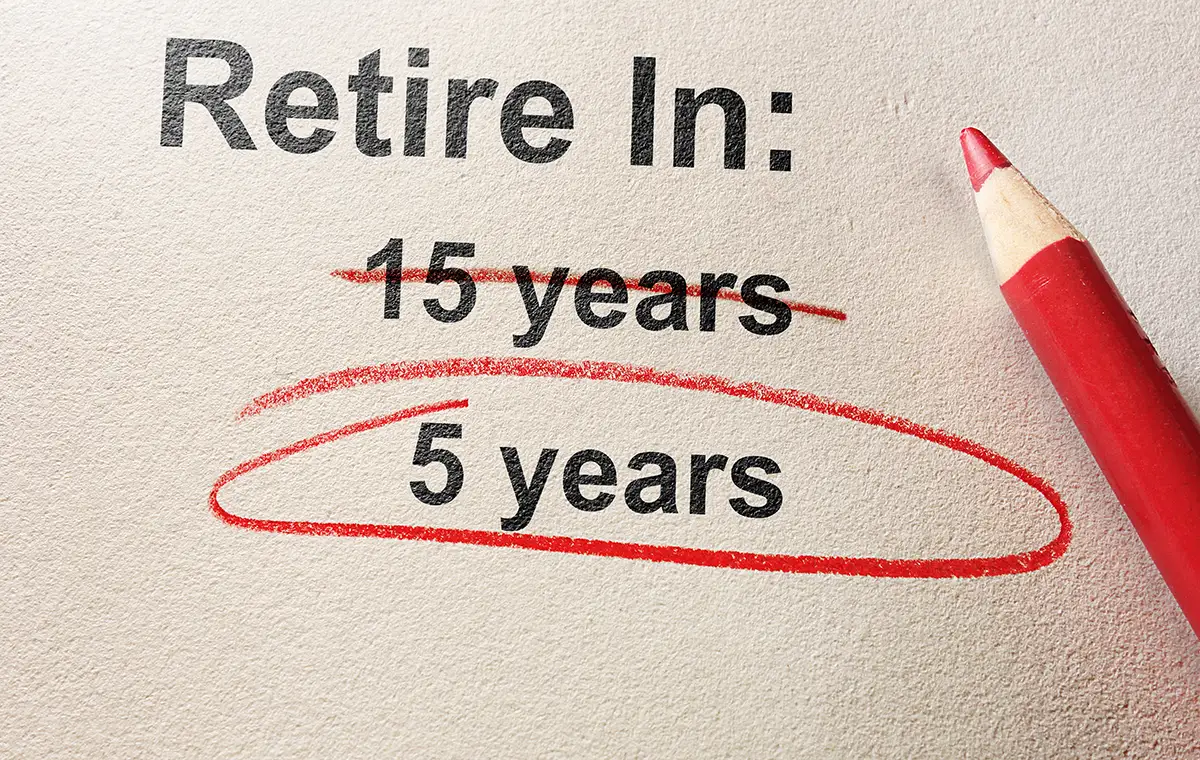What is the advantage of investing for retirement early? (+ examples)
What is the advantage of investing for retirement early? (+ examples) It’s an exciting time of your life when you’re between 25 and 35 years old:...

Let's be honest. Once you reach the age of 40, things start to feel ... well, a bit more real, right?
It's an age where you may have thought you'd have everything figured out. All of those big life questions and "I'll get to that later!" tasks — like investing for retirement — that you had put on the back-burner start to creep back in as you realize "later" is right now.

Soon, every conceivable question you've potentially put off until this moment starts to rush toward the forefront of your mind:
As much as I would love to talk with each of you about any of the above questions (enter Socrates quote here), let’s focus on the last one.
Well, if you’re 40, then probably so. What will that look like? Well, dear reader, much of that depends on you and the decisions you make over the next 20 to 30 years.
After examining your life and your goals, you will need to save diligently, financially plan wisely and invest prudently in order to one day arrive at a place where you can reasonably and comfortably retire. And the great news is, if you’re in your 40s, time is still on your side.
Retirement planning is an umbrella term describing all of the financial planning involved in getting you eventually to the point of financial independence – where you no longer have to work for a living.
This typically coincides roughly with the age at which you are eligible for Medicare (65) and Social Security (67 if you were born 1960 or later). Retirement planning can be as simple as using popular rule-of-thumb guidelines or as complicated as you want to make it — think Excel spreadsheets and Monte Carlo simulators.
I prefer to keep things simple when this is sufficient. The earlier you start thinking about and planning for retirement, the simpler your plan can be. At age 40, you still have two or three decades to work with.
Since we love rules-of-thumb and keeping things simple, let’s say you plan to retire at age 65. At 65, you are eligible for Medicare benefits; part A is free and part B is affordable for most people. You are no longer dependent on your employer to help provide you with affordable health insurance.
You can receive partial Social Security benefits as early as age 62, “full” benefits at 67, and maximum benefits if you wait until age 70. Just FYI, the average retirement age in the United States is 64 years old. If you’re currently 40 and you plan to retire at 65, this leaves you with 25 years remaining in the workforce.
My favorite rule-of-thumb for this is just use age 95. The average life expectancy for men in the Untied States is currently age 73, and the average life expectancy for women is the United States is currently 79 years old.
Have parents who’ve lived longer than this? Great. Use age 95 and you’ll be covered in by far the majority of cases. If you retire at 65 and live until age 95, you will have spent 30 years in retirement.
You can use this information to give yourself some idea of how long you will work, how long you will be in retirement, and therefore how much money you need to save in the first half of the equation to fund the latter half.
Most experts recommend saving between 10 to 15% of your annual income for retirement. This means that if you are making $50,000 a year, you should save around $5,000 to $7,500 a year towards retirement. I love this method because it’s easy and it works, if you start towards the beginning of your career – at say, age 25 or 26 and save consistently right up until retirement.
Even if you’re starting from scratch at age 40, however, 10 to 15% builds a solid retirement savings foundation over a 25-year period.
A 40-year-old earning $50,000 could have $445,883 saved for retirement by age 65 (assuming a 10% retirement savings rate, 3% annual salary increase, and a 7% average investment return). This is probably not enough to get you through retirement, though it’s not too shabby, either.
Start with a 10% savings rate. Each year, bump your savings up by 1% until you reach 20% at age 50. This would give you (using same assumptions as above) $758,048 at age 65. If you’re married and receiving Social Security, this amount could last you until age 92.
The amount you need to have saved for retirement in order to make it through retirement without having to return to work (or resort to living in you child’s basement and eating cat food).
In the above savings example, $758,048 is the “number” that will fund our hypothetical retiree to age 92. The earlier you are in the retirement planning process, the harder this is to pin down, because there are so many things that could change between now and your retirement.
If you’re 40, you make $50,000 a year, you’re saving 10% towards retirement, and you’re spending the rest, well, you now know you need $45,000 a year to pay your bills and live your life. You can plug your stats into a retirement calculator, assume that you will need about 80% of your pre-retirement income during retirement, and voila, the calculator will spit out a number you need to have saved by age 65 in order to fund your living expenses through age 95.
Keep in mind, though, most 40-year-olds have student loan or other debt, a mortgage payment, child care, and other expenses that will either be eliminated (hopefully) or will at the very least look quite different in retirement. I would recommend less focus on your number and more focus on your savings rate at this stage.
There are a several variables to consider here:
This is subject to change at any time, but we can work with what we know and adjust the investment plan accordingly. One thing you have a fair amount of control over is how much you save.
You should attempt to maximize this, especially if you’re just starting at 40. Also, keep in mind that “average percentage rate” over 25 years looks nothing like annual percentage rate. Try to maintain a long-term focus.
This is a total wild card. Your investment success has as much to do with where in the market cycle you begin and end your journey as anything else. Professionals can help you navigate this landscape, but not perfectly.
If you can make peace with this fact, you will have the mental clarity to make better investment decisions than most investors.
This is often overlooked or glossed over, but it is extremely important. You may want to invest aggressively because you want growth and you have a long time horizon. However, if your nerves can’t handle the volatility of an all-stock portfolio (which could lose over 50% of its value in a bear market), you may make mistakes that you never fully recover from.
It’s crucial to understand your temperament and how you are likely to react to market events. Choose an asset allocation in line with your temperament and your risk tolerance.
Mathematically, you should take the amount of risk necessary to get the returns you need to reach your financial goals in the time period you have. A study of asset allocation and historical market performance can help you with this. A retirement calculator will also be greatly beneficial.
Temperamentally, however, you should take only the amount of investment risk you can physically and emotionally tolerate. Experience can teach you this. Risk tolerance questionnaires can also help. Keep in mind that your risk tolerance should decrease as you age and get closer to retirement.
How you develop your investment strategy is a highly personal decision, particularly when it you're thinking about retirement. Most retirement accounts are invested in a mixture of stocks, bonds, cash, and perhaps alternative investments (real estate, commodities, precious metals, etc.).
At age 40, you probably need a mixture of stocks and bonds. You probably need very little cash, and you probably don’t need any alternative investments (in my opinion). You can hold individual stocks and bonds, or you can hold a broad basket of stocks and bonds in the form of exchange traded funds (ETFs) or mutual funds.
In recent years, ETFs have outpaced mutual funds in popularity. I think they’re both good options. Individual stocks (and to a much lesser degree, individual bonds) are considered riskier than mutual funds or ETFs, because you’re typically not spreading the risk out across as many companies or market sectors.
Diversification essentially means “not putting all your eggs in one basket.” With investments, this means you avoid putting all of your money in one or a few things – it’s safer to spread your money around across various asset classes (stocks, bonds, cash, etc.), various market sectors (tech, utilities, healthcare, energy), various companies, and even various countries.
If your investments are well-diversified and one of the companies you are invested in goes bankrupt (which happens all the time), your overall portfolio is not greatly impacted.
Asset allocation refers to the specific percentage of stocks, bonds, cash, and other investments in your portfolio. Again, this can be as simple or as complex as you want to make it. A simple version would be to hold 60% of your account in a Total Stock Market fund and 40% in a Total Bond Market fund, assuming that this is in line with your goals and your risk tolerance.
As the market fluctuates over time, these percentages will drift away from your target 60/40 allocation. This can be corrected by rebalancing your account on a set schedule (quarterly, annually, or other) to keep you close to your desired asset allocation.
If you want to get fancy, your stocks can be further broken down by geographic location (U.S., International, and Emerging Markets, for example) or by market capitalization (large-cap, mid-cap, and small cap). Your bonds can be separated by issuer, credit quality, and other features. If done correctly, this may give you a slight edge in your returns when it comes to risk vs. reward.
The above is just an example. Your goals, risk-tolerance, and time-frame are key! A financial advisor can help you build a plan uniquely tailored to your needs.
Whew – that was a LOT! Now, before you start upending your savings and investment strategy, I want you to pause and think back to the questions posed in the introductory paragraph. Particularly, these three:
It's important for you to answer these questions fully and honestly for yourself and no one else. Because when you save for retirement, you need to remember your savings and investments are merely tools for how to get closer to living out what matters.
Enjoy the journey! If you have questions or want to learn more, feel free to schedule an appointment. We look forward to hearing from you soon.

What is the advantage of investing for retirement early? (+ examples) It’s an exciting time of your life when you’re between 25 and 35 years old:...

Let’s be honest. If you’re here to learn about estate planning costs, we’re about to walk into a conversation that no one really wants to have. It...

If you’re reading this right now, and you’re in your 30s, I am willing to wager that you get in the abstract sense why planning early for retirement...

1 min read
As the title implies, you’re here because you want to develop a deeper understanding of what the true risks of investing are, and this may be for a...

Why the Stock Market Must Crack The Long Hot Summer is a perennial favorite movie in our house. Yes, our home is full of teenage girls, but films...

Tax savings strategies for high income earners (+ examples) If you're here, you are most certainly not looking for a leisurely read to pass the time...